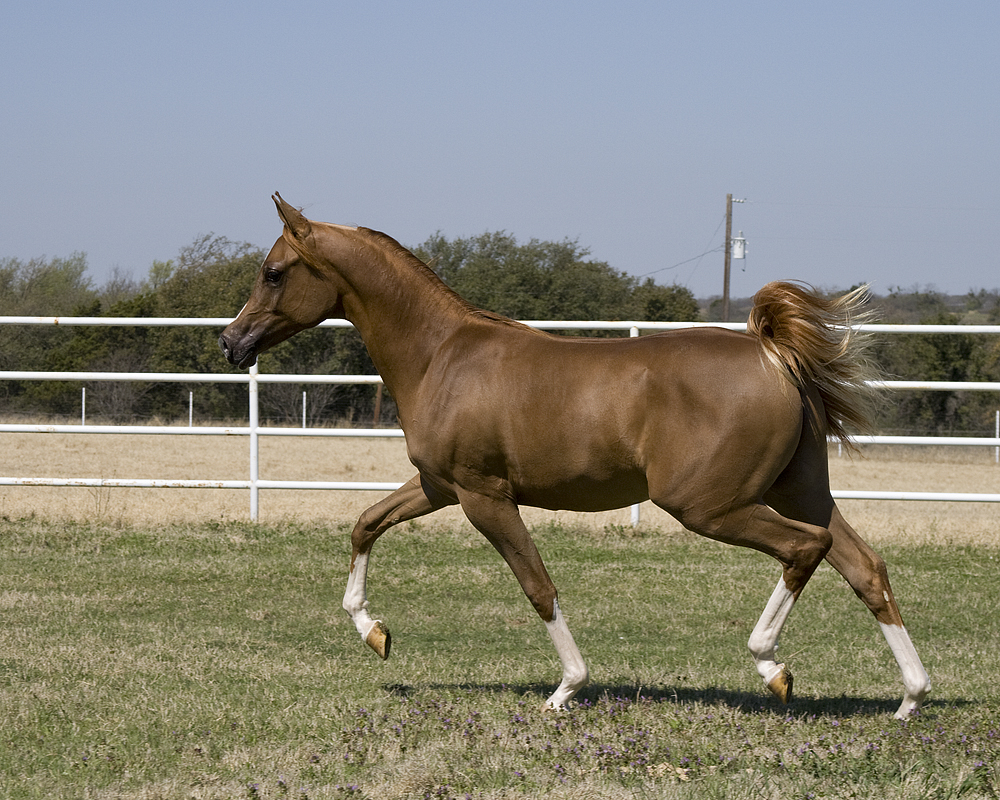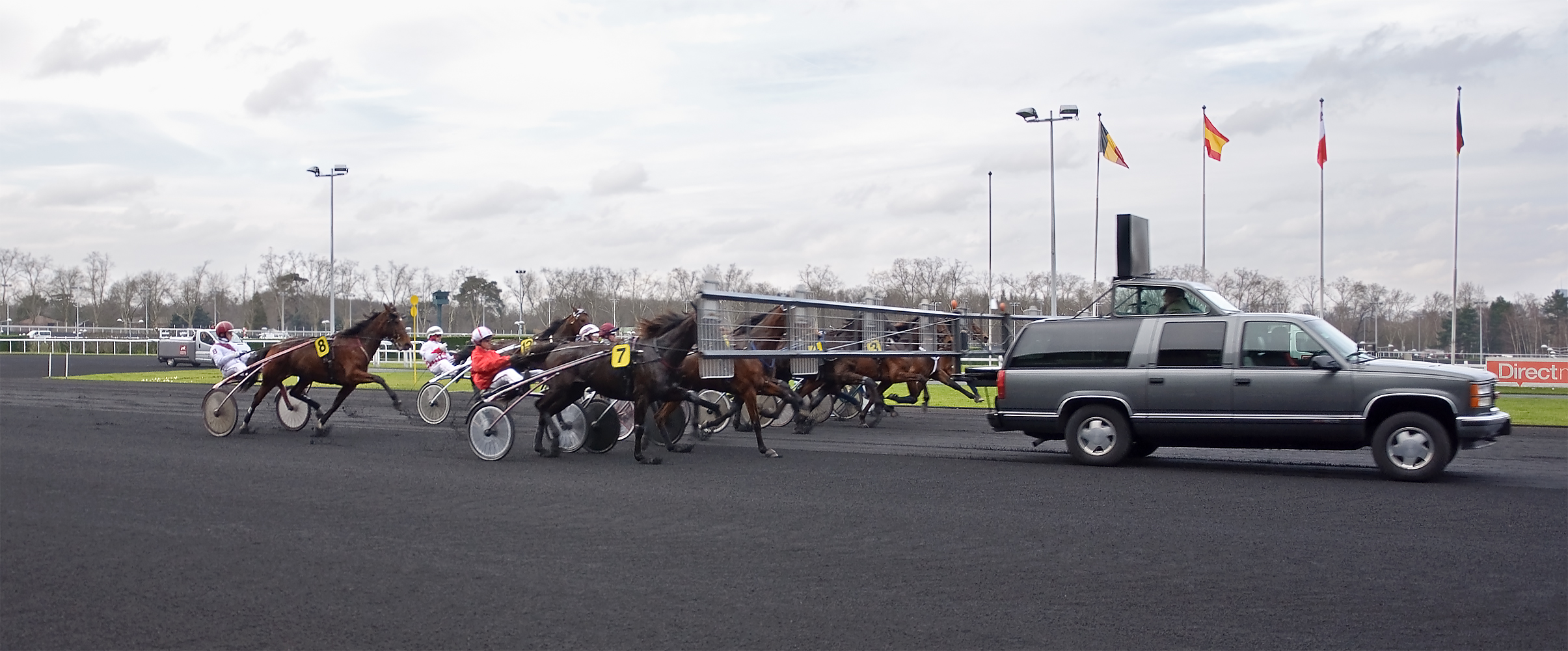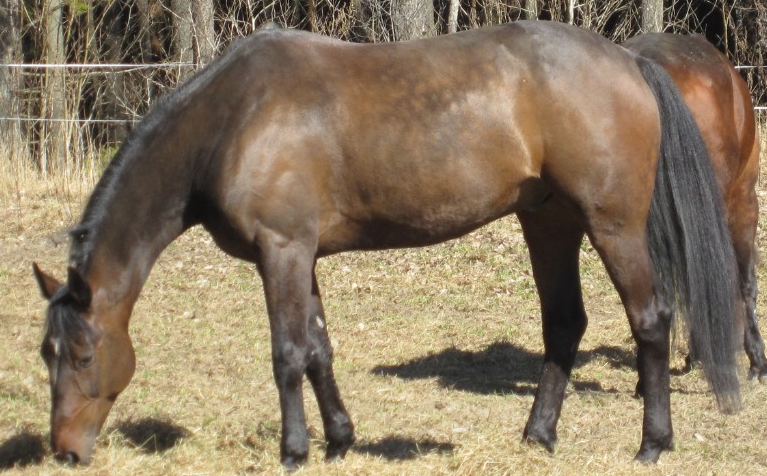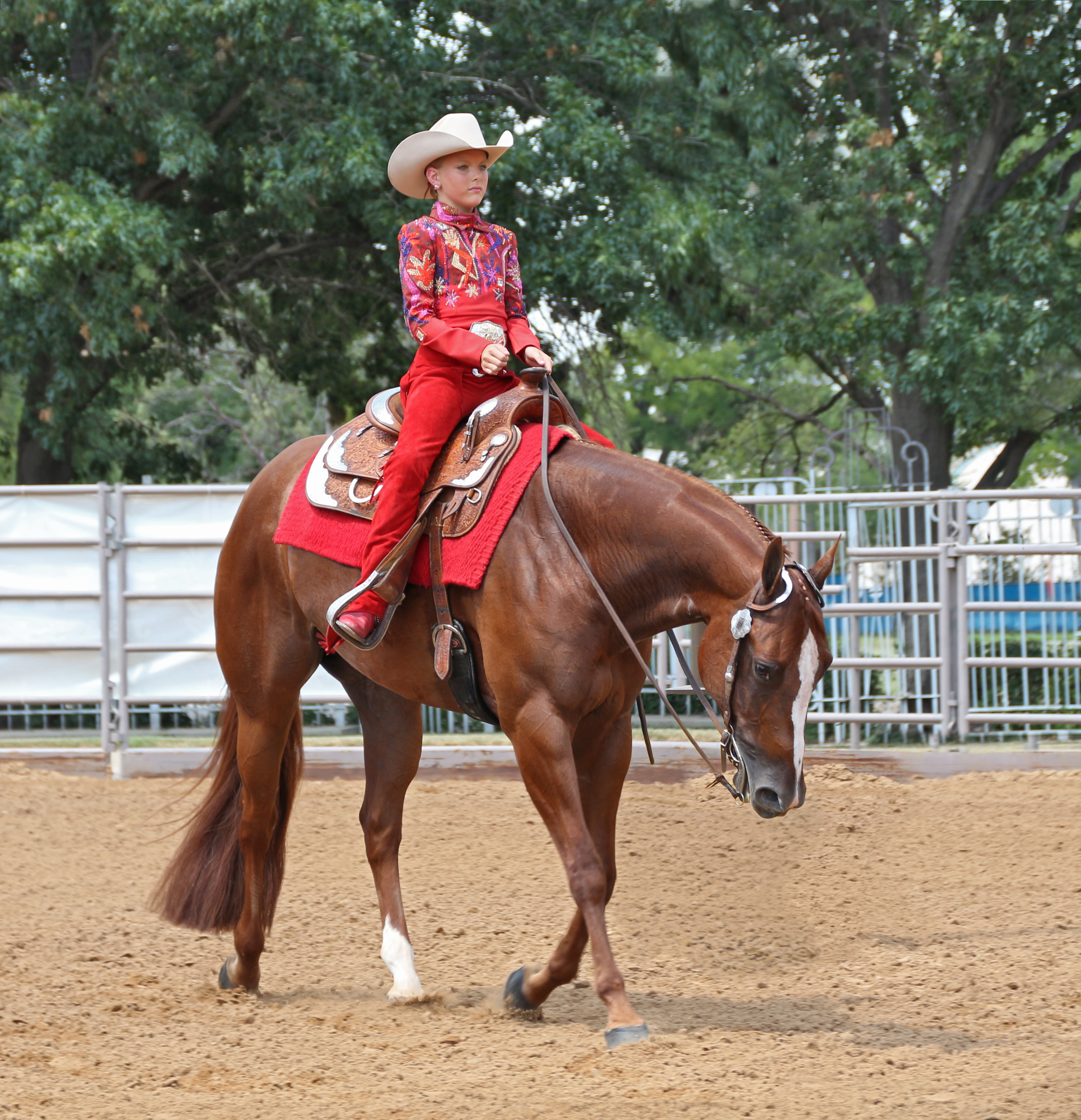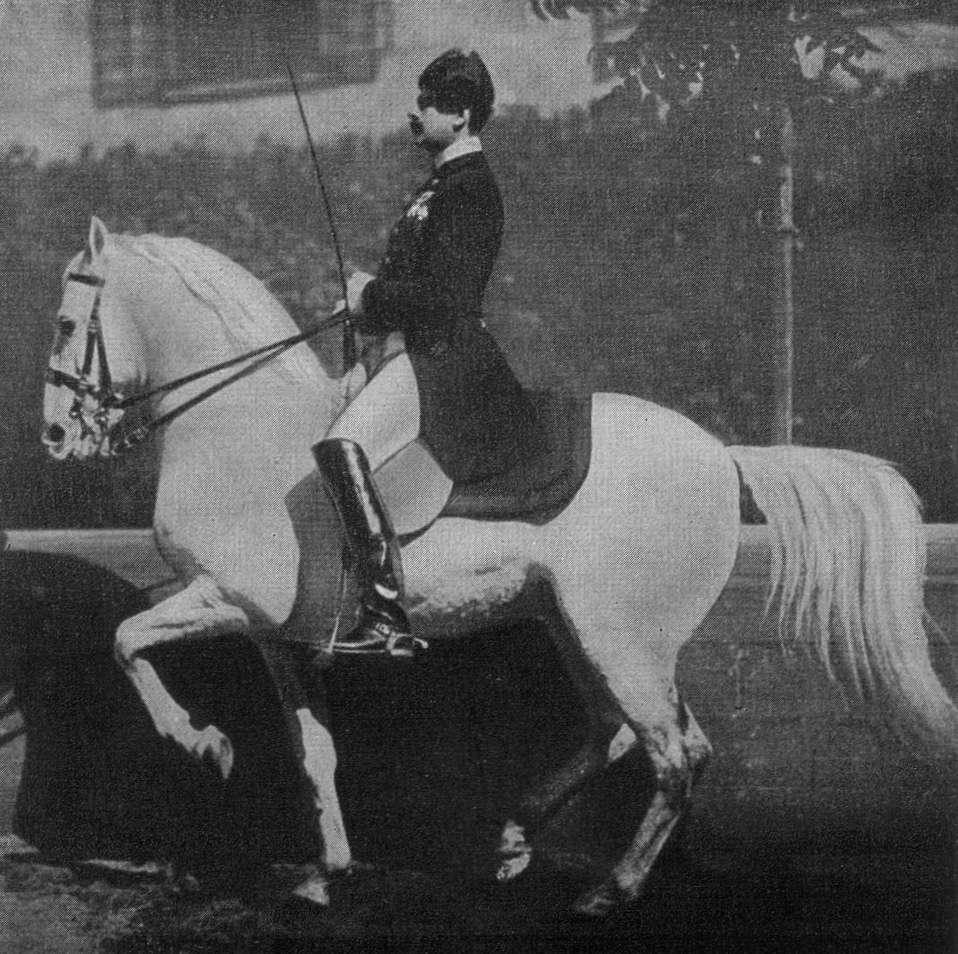|
Trot
The trot is a two-beat diagonal horse gait where the diagonal pairs of legs move forward at the same time with a moment of suspension between each beat. It has a wide variation in possible speeds, but averages about . A very slow trot is sometimes referred to as a jog. An extremely fast trot has no special name, but in harness racing, the trot of a Standardbred is faster than the gallop of the average non-racehorse, and has been clocked at over . On June 29, 2014, at Pocono Downs in Pennsylvania the Swedish standardbred Sebastian K trotted a mile in 1 minute, 49 seconds (quarters were passed at 26:2, 55:3 and 1,21:4). This is equivalent to a 1000-pace in 1.07,7 or 53.14 kilometers per hour or 33 miles per hour. From the standpoint of the balance of the horse, the trot is a very stable gait and does not require the horse to make major balancing motions with its head and neck.Harris, Susan E. ''Horse Gaits, Balance and Movement'' New York: Howell Book House 1993 pp. 35–37 ... [...More Info...] [...Related Items...] OR: [Wikipedia] [Google] [Baidu] |
Harness Racing
Harness racing is a form of horse racing in which the horses race at a specific gait (a trot or a pace). They usually pull a two-wheeled cart called a sulky, spider, or chariot occupied by a driver. In Europe, and less frequently in Australia and New Zealand, races with jockeys riding directly on saddled trotters ( in French) are also conducted. Breeds In North America, harness races are restricted to Standardbred horses, although European racehorses may also be French Trotters or Russian Trotters, or have mixed ancestry with lineages from multiple breeds. Orlov Trotters race separately in Russia. The light cold-blooded Coldblood trotters and Finnhorses race separately in Finland, Norway and Sweden. Standardbreds are so named because in the early years of the Standardbred stud book, only horses who could trot or pace a mile in a ''standard'' time (or whose progeny could do so) of no more than 2 minutes, 30 seconds were admitted to the book. The horses have proportiona ... [...More Info...] [...Related Items...] OR: [Wikipedia] [Google] [Baidu] |
Standardbred
The Standardbred is an American horse breed best known for its ability in harness racing where they compete at either a trot or pace. Developed in North America, the Standardbred is recognized worldwide, and the breed can trace its bloodlines to 18th-century England. They are solid, well-built horses with good dispositions. Characteristics Standardbreds are generally well-muscled and similar to, but a bit heavier than, a Thoroughbred, with a large head often with a Roman nose profile, straight neck, sloping shoulder, defined withers, a deep girth, strong bone (legs) and hard feet. Standardbreds average and typically weigh between . They are most often bay, and less frequently brown, black, chestnut, gray or roan. Standardbreds are considered easy-to-train horses with a willing submissive nature. Gaits Standardbreds race either at a trot or pace. In the trot, the horse's legs move in diagonal pairs; when the right foreleg moves forward, so does the left hind l ... [...More Info...] [...Related Items...] OR: [Wikipedia] [Google] [Baidu] |
Horse Racing
Horse racing is an equestrian performance activity, typically involving two or more horses ridden by jockeys (or sometimes driven without riders) over a set distance for competition. It is one of the most ancient of all sports, as its basic premise – to identify which of two or more horses is the fastest over a set course or distance – has been mostly unchanged since at least classical antiquity. Horse races vary widely in format, and many countries have developed their own particular traditions around the sport. Variations include restricting races to particular breeds, running over obstacles, running over different distances, running on different track surfaces, and running in different gaits. In some races, horses are assigned different weights to carry to reflect differences in ability, a process known as handicapping. While horses are sometimes raced purely for sport, a major part of horse racing's interest and economic importance is in the gambling associated ... [...More Info...] [...Related Items...] OR: [Wikipedia] [Google] [Baidu] |
Ambling
An ambling gait or amble is any of several four-beat intermediate horse gaits, all of which are faster than a walk but usually slower than a canter and always slower than a gallop. Horses that amble are sometimes referred to as " gaited", particularly in the United States. Ambling gaits are smoother for a rider than either the two-beat trot or pace and most can be sustained for relatively long periods, making them particularly desirable for trail riding and other tasks where a rider must spend long periods in the saddle. Historically, horses able to amble were highly desired for riding long distances on poor roads. Once roads improved and carriage travel became popular, their use declined in Europe but continued in popularity in the Americas, particularly in areas where plantation agriculture was practiced and the inspection of fields and crops necessitated long daily rides. The ability to perform an ambling gait is usually an inherited trait. In 2012, a DNA study found th ... [...More Info...] [...Related Items...] OR: [Wikipedia] [Google] [Baidu] |
Trot Animated
The trot is a two-beat diagonal horse gait where the diagonal pairs of legs move forward at the same time with a moment of suspension between each beat. It has a wide variation in possible speeds, but averages about . A very slow trot is sometimes referred to as a jog. An extremely fast trot has no special name, but in harness racing, the trot of a Standardbred is faster than the gallop of the average non-racehorse, and has been clocked at over . On June 29, 2014, at Pocono Downs in Pennsylvania the Swedish standardbred Sebastian K trotted a mile in 1 minute, 49 seconds (quarters were passed at 26:2, 55:3 and 1,21:4). This is equivalent to a 1000-pace in 1.07,7 or 53.14 kilometers per hour or 33 miles per hour. From the standpoint of the balance of the horse, the trot is a very stable gait and does not require the horse to make major balancing motions with its head and neck.Harris, Susan E. ''Horse Gaits, Balance and Movement'' New York: Howell Book House 1993 pp. 35–37 ... [...More Info...] [...Related Items...] OR: [Wikipedia] [Google] [Baidu] |
Horse Gait
Horses can use various gaits (patterns of leg movement) during Terrestrial locomotion, locomotion across solid ground, either naturally or as a result of specialized horse training, training by humans.Ensminger, M. E. ''Horses and Horsemanship'' 6th edition USA: Interstate Publishers 1990 pp. 65–66 Classification Gait, Gaits are typically categorized into two groups: the "natural" gaits that most horses will use without special training, and the "Ambling gait, ambling" gaits that are various smooth-riding, four-beat footfall patterns that may appear naturally in some individuals. Special training is often required before a horse will perform an ambling gait in response to a equestrianism, rider's command. Another system of classification that applies to Quadrupedalism, quadrupeds uses three categories: walking and ambling gaits, running or trotting gaits, and leaping gaits.Tristan David Martin Roberts (1995) ''Understanding Balance: The Mechanics of Posture and Locomotion'', ... [...More Info...] [...Related Items...] OR: [Wikipedia] [Google] [Baidu] |
Arabian Horse
The Arabian or Arab horse ( , DIN 31635, DMG ''al-ḥiṣān al-ʿarabī'') is a horse breed, breed of horse with historic roots on the Arabian Peninsula. With a distinctive head shape and high tail carriage, the Arabian is one of the most easily recognizable horse breeds in the world. It is also one of the oldest modern breeds. Although modern DNA cannot trace breed purity in the modern population beyond 200 years, there is archaeological evidence of horses in the Middle East with landrace characteristics that resemble modern Arabians dating back 3,500 years. Arabian horses have spread around the world by both war and trade, being used to improve other breeds by adding speed, refinement, endurance, and strong bone. Today, Arabian bloodlines are found in almost every modern breed of riding horse. The Arabian developed in a desert climate and was prized by the nomadic Bedouin people, often being brought inside the family tent for shelter and protection from theft. Selective ... [...More Info...] [...Related Items...] OR: [Wikipedia] [Google] [Baidu] |
Paso Fino
The Paso Fino is a naturally gaited light horse breed dating back to horses imported to the Caribbean from Spain. ''Pasos'' are prized for their smooth, natural, four-beat, lateral ambling gait; they are used in many disciplines, but are especially popular for trail riding. In the United States two main groups of horses are popularly called "Paso Fino": One, also known as the Paso Fino Puro Puertorriqueño, originated in Puerto Rico. The other, often called the Colombian Paso Fino or Colombian Criollo Horse, developed in Colombia. Though from similar Spanish ancestors, the two groups developed independently of one another in their home nations. History The Paso Fino name means 'fine step'. The Paso Fino is a blend of the Barb, Spanish Jennet, and Andalusian horse and was bred by Spanish land owners in Puerto Rico and Colombia to be used in the plantations because of their endurance and comfortable ride. All Pasos share their heritage with the Peruvian Paso, the American Mu ... [...More Info...] [...Related Items...] OR: [Wikipedia] [Google] [Baidu] |
Passage (dressage)
{{Short description, Equestrian movement pattern The passage is a movement seen in upper-level dressage Dressage ( or ; , most commonly translated as "training") is a form of horse riding performed in exhibition and competition, as well as an art sometimes pursued solely for the sake of mastery. As an equestrianism, equestrian sport defined by th ..., in which the horse performs a highly elevated and extremely powerful trot. The horse is very collected and moves with great impulsion. The passage differs from the working, medium, collected, and extended trot in that the horse raises a diagonal pair high off the ground and suspends the leg for a longer period than seen in the other trot types. The hindquarters are very engaged, and the knees and hocks are flexed more than the other trot types. The horse appears to trot in slow motion, making it look as if it is dancing. The passage is first introduced in the dressage intermediaire test II. A horse must be well-confirmed in ... [...More Info...] [...Related Items...] OR: [Wikipedia] [Google] [Baidu] |
Piaffe
The piaffe () is a dressage movement where the horse is in a highly collected and cadenced trot, in place or nearly in place. The center of gravity of the horse should be more towards the hind end, with the hindquarters slightly lowered and great bending of the joints in the hind legs. The front end of the horse is highly mobile, free, and light, with great flexion in the joints of the front legs, and the horse remains light in the hand. The horse should retain a clear and even rhythm, show great impulsion, and ideally should have a moment of suspension between the foot falls. As in all dressage, the horse should perform in a calm manner and remain on the bit with a round back.Carlos Henriques Pereira, « Le piaffer », dans Dressage et Ethologie, Editions Amphora, 2011, 285 pp. 202-211. The piaffe was originally used in battle to keep the horse focused, warm, and moving, ready to move forward into battle. In modern times, the piaffe is mostly taught as an upper level movemen ... [...More Info...] [...Related Items...] OR: [Wikipedia] [Google] [Baidu] |
Morgan Horse
The Morgan horse is one of the earliest horse breeds developed in the United States. Tracing back to the foundation bloodstock, foundation sire Figure (horse), Figure, later named Justin Morgan after his best-known owner, Morgans served many roles in 19th-century American history, being used as coach horses and for harness racing, as general riding animals, and as cavalry horses during the American Civil War on both sides of the conflict. Morgans have influenced other major American breeds, including the American Quarter Horse, Tennessee Walking Horse and the Standardbred. During the 19th and 20th centuries, they were exported to other countries, including England, where a Morgan stallion influenced the breeding of the Hackney horse. In 1907, the US Department of Agriculture established the University of Vermont Morgan Horse Farm, US Morgan Horse Farm near Middlebury, Vermont for the purpose of perpetuating and improving the Morgan breed; the farm was later transferred to th ... [...More Info...] [...Related Items...] OR: [Wikipedia] [Google] [Baidu] |
Saddle Seat
Saddle seat is a style of equestrianism, horse riding within the category of English riding that is designed to show off the high action of certain list of horse breeds, horse breeds. The style developed into its modern form in the United States, and is also seen in Canada and South Africa. To a much lesser extent, it is ridden with American horse breeds in Europe and Australia. The goal of the saddle seat riding style is to show off the horse's extravagant gaits, particularly the trot. It is not to be confused with the various hunt seat disciplines. History Saddle seat riding began as a distinct style within the broader group of English riding disciplines developed in the United States. The first source was the Plantation tradition of the Southern United States, American South, where smooth-moving, high-stepping horses were used by plantation owners and overseers to travel across the fields. The horses had to be smooth riding and comfortable enough for hours of riding while over ... [...More Info...] [...Related Items...] OR: [Wikipedia] [Google] [Baidu] |
